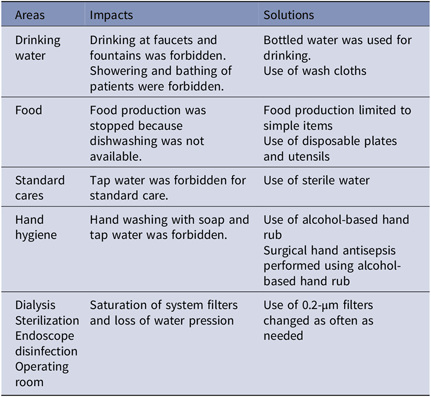To the Editor—Healthcare facilities are dependent on water supplies to deliver daily patient care. The water used for care and consumption in hospitals meets strict regulations for microbiological criteria (eg, absence of Escherichia coli, enterococci, and coliforms). 1,2 In France, drinking water is provided by the city, which ensures water potability. 3,4 In our hospital, which hosts ∼2,500 beds at 2 main sites, this water can be directly used for standard care such as hand washing, bathing of patients, or reprocessing of medical equipment. It can also undergo treatment for use in intensive care units, operating rooms, and for hemodialysis, sterilization of surgical instruments, and endoscope disinfection.
Water supply interruptions remain very rare in French hospitals, but in November 2018, the entire water network of the Brest teaching hospital was polluted as a result of construction damage to the public water system. This event resulted in a major increase of the water turbidity from 0.20 to 8 NTU (nephelometric turbidity units) and caused emergency water supply interruption. We had no emergency water supply plan (EWSP), as recommended by the Center for Disease Control and Prevention, and we had to improvise our responses. 5
Specific measures were taken by the Infection Control Unit in agreement with hospital leadership (Table 1). Drinking at faucets and fountains was forbidden and bottles of mineral water were distributed in units for patients and health workers. The use of tap water for standard care was stopped, and we asked health workers to use bottles of sterile water. Showering and bathing of patients were forbidden, as was hand washing with soap and tap water. We recommended the use of an alcohol-based hand rub as the preferred means for routine hand antisepsis in all clinical situations. Surgical hand antisepsis also had to be performed using alcohol-based hand rub. Many 0.2-µm filters used for dialysis systems, in sterilization units, endoscopes disinfection areas, and especially in operating rooms were saturated. This resulted in a lack of pressure in dialysis systems, for example. We had to change filters regularly to maintain care. Food production was stopped and was limited to simple items. Disposable plates and utensils were used because dishwashing was not available.
Table 1. Impacts of Water Supply Interruption and Adopted Solutions

The water supply was disrupted for 24 hours; it was solved by repairs on the public water system and a global purge of the hospital water system until the return of normal water turbidity. Water potability controls were implemented at different places in the hospital to represent the entire water system.
A few days after the episode, some potability controls for drinking fountains in different places in the hospital showed the presence of 1 pathogenic bacterium. This bacterium, the Enterobacteriaceae Lelliottia amnigena, was found in 4 different units and at remote locations within the hospital.
The presence of this bacterium was probably due to the water pollution, contamination of the drinking fountain system, and the diffusion of a biofilm into the hospital water network. Therefore, we had to make new controls for water potability of all the contaminated drinking fountains after disinfection. No digestive infections were reported following this accident, nor were adverse events due to the use of dialysis machines found during the episode.
This type of accident is unusual, but it must be anticipated. In hospitals, an action plan should be created to be fully prepared in case of such an accident. One of the most difficult decisions was when to authorize people to use the water from the hospital water system again. On one hand, it was difficult to stop the use of a water system for a long time while awaiting microbiological result because it disrupted the proper functioning of the hospital. On the other hand, there was a risk of endangering patients, staff, and visitors if we decided to use the water too soon. We finally decided to allow the use of water once the turbidity returned to normal (ie, 0.20 NTU).
Following this accident, the hospital decided to write an emergency water supply plan to deal with a new episode of water contamination.
Acknowledgments
The authors are grateful to Claudie Le Moigne and Monique Magnin for their contribution to the microbiological testing.
Financial support
No financial support was provided relevant to this article.
Conflicts of interest
All authors report no conflicts of interest relevant to this article



